EASY CLICKS
Netaji Subhas Chandra Bose International Airport
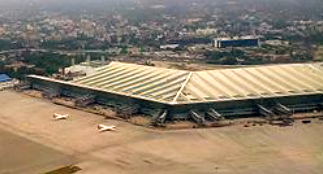
CCU
Location of airport in West Bengal
| Summary | |
|---|---|
| Airport type | Public |
| Owner/Operator | Airports Authority of India |
| Serves | Kolkata |
| Location | Kolkata, India |
| Hub for |
|
| Elevation AMSL | 5m / 16ft |
| Coordinates | 22°39′17″N 088°26′48″E / 22.65472°N 88.44667°E |
| Website | http://www.aai.aero/kolkata/index.jsp |
| Runways | |||
| Direction | Length | Surface | |
| m | ft | ||
| 01L/19R | 3,300 | 11,055 | Asphalt |
| 01R/19L | 3,860 | 12,208 | Asphalt |
| Statistics (Apr '12 – Mar '13) | |||
| Passenger movements | 10,169,386 | ||
| Aircraft movements | 93,330 | ||
| Cargo tonnage | 122,232 | ||
Netaji Subhas Chandra Bose International Airport (IATA: CCU, ICAO: VECC) is an international airport located in Kolkata, West Bengal, India, serving the Kolkata metropolitan area. It is located approximately 17 km (11 mi) from the city center. The airport was earlier known as Dum Dum Airport before being renamed after Netaji Subhas Chandra Bose, a prominent leader of Indian independence movement. Spread over an area of 1670 acres, Kolkata airport is the largest in eastern India and one of only two international airports operating in West Bengal, the other being in Bagdogra. It is the fifth busiest airport of India in terms of passenger traffic and is a major center for flights to North-East India, Bangladesh and Southeast Asia.
Contents
- 1 History
- 1.1 Modernisation
- 2 Airport structure
- 3 Expansion
- 4 Connectivity
- 4.1 Navigation
- 5 Airlines and destinations
- 5.1 Passenger
- 5.2 Cargo
History
Kolkata airport traditionally served as a strategic stopover on the air route from Europe to Indochina and Australia. Many pioneering flights passed through the airport, including that of Amelia Earhart in 1937. In 1924, KLM began scheduled stops at Calcutta, as part of their Amsterdam to Batavia (Jakarta) flight. The same year, a Royal Air Force aircraft landed in Calcutta as part of the first round-the-world expedition by any air force.
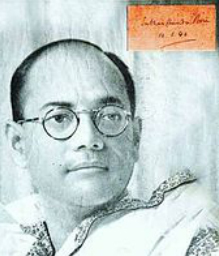
Netaji Subhash Chandra Bose, after whom the airport is named
The airport began as an open ground next to the Royal Artillery Armoury in Dum Dum. Sir Stanley Jackson, Governor of Bengal, opened the Bengal Flying Club at Calcutta aerodrome in February 1929. In 1930, the airfield was made fit for use throughout the year, and other airlines began to utilise the airport. Air Orient began scheduled stops as part of a Paris to Saigon route, and Imperial Airways began flights from London to Australia via Calcutta in 1933. This began a trend that drew many airlines to Calcutta airport.
Calcutta played an important role in the Second World War. In 1942, the United States Army Air Forces 7th Bombardment Group flew B-24 Liberator bombers from the airport on combat missions over Burma. The airfield was used as a cargo aerial port for the Air Transport Command, and was also used as a communication center for the Tenth Air Force.
Passenger services grew after the Second World War. Calcutta became a destination for the world’s first jet-powered passenger aircraft, the de Havilland Comet, on a British Overseas Airways Corporation (BOAC) route to London. Furthermore, in 1964 Indian Airlines introduced the first Indian domestic jet service, using Caravelle jets on the Calcutta–Delhi route.
Between the 1940s and 1960s, the airport was served by several major airlines including Aeroflot, Air France, Alitalia, Cathay Pacific, Japan Airlines, Philippine Airlines, KLM, Pan Am, Lufthansa, Swissair and SAS.
Due to the introduction of longer haul aircraft and the poor political climate of Calcutta during the 1960s, several airlines discontinued their service to the airport. The 1971 Bangladesh Liberation War saw a large increase of both refugees and disease in Calcutta, causing more airlines to cease services to the city. In 1975, the airport opened the first dedicated cargo terminal in India.
In the early 1980s, plans emerged to connect the airport with the city center by tram. The proposed route went to the airport from Maniktala, via Vivekananda Road, Ultadanga and Kazi Nazrul Islam Avenue. The line partly completed 1985, but further expansion to the airport was cancelled due to the financial downing of Calcutta Tramways Company. The extension proposal re-appeared in 1999, but was cancelled.
The 1990s saw new growth for Calcutta airport, as the Indian aviation industry saw the arrival of new airlines such as Jet Airways and Air Sahara. A new domestic terminal was opened in 1995, and the airport was renamed in honour of Netaji Subhas Chandra Bose. In 2000, a new international arrival hall was opened.
Modernisation
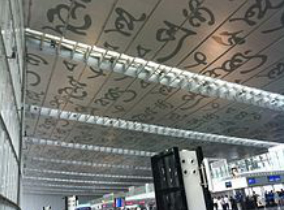
The interior of the new departure area.
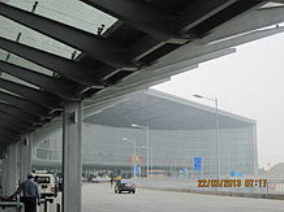
View of the new Terminal from outside.
2005 saw the growth of Low Cost Carriers in the Indian aviation sector, with new airlines including Spice Jet, IndiGo and Kingfisher Airlines. This led to a dramatic rise in passenger numbers at the airport. Overcrowding in both terminals led to the implementation of a comprehensive modernisation plan for the airport
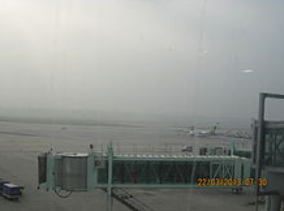
One of the many aerobridges that were imported from Indonesia. Work included an expansion of runway 01L/19R, rapid-exit taxiways and parking bays. The runway was extended by 400 m (1,300 ft) on the northern side and 1000 ft on the southern side, and was fitted with CAT-I facilities for night use. A 119-year old mosque that lies 30 meters from the runway' northern end prohibits further expansion in this direction. The longer runway, 01R/19L, was upgraded from CAT-I to CAT-II ILS status to allow landings in poor visibility. The former airport hotel 'Ashok' was demolished to
give way to two new five-star luxury hotels and a shopping mall in its place. Future modernisation plans include the construction of an 86 meter high Air Traffic Control Tower . The modernisation plan included some improvements of the airport's existing terminals, including the addition of extra ticketing counters, check-in kiosks and cafes to the domestic terminal in 2009. However, the need to replace the airport's terminals entirely led to plans for a new integrated terminal to serve both international and domestic destinations. A Thai-based company, the Italian-Thai Development (ITD) Corporation (ITD-ITDCem JV, a consortium of ITD and ITD Cementation) was hired with Delhi-based designer Sikka Associates to construct the building. Construction commenced in November 2008, and the terminal was inaugurated on 20 January 2013 after overshooting the previous deadlines of July 2011 and August 2012.
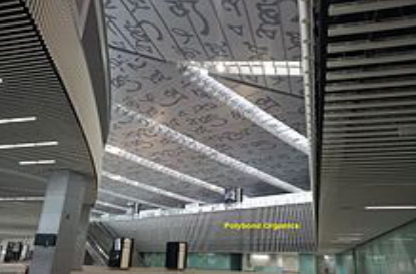
Ceiling of the terminal have "Honey comb ceilings" and "Tube line system" which incorporate the writings of Rabindranath Tagore of Bengal. Commercial operations were intended to start on 23 January 2013, the 116th birth anniversary of Netaji Subhas Chandra Bose. However, the shift to the new terminal was only completed on the 16th of March.
Airport structure
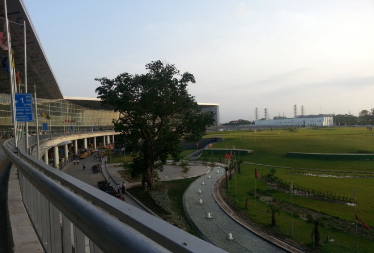
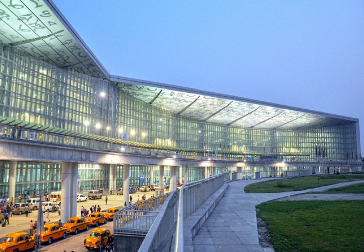
The city side area in the New Integrated Terminal
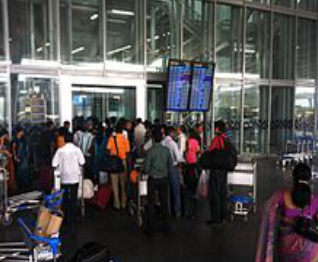
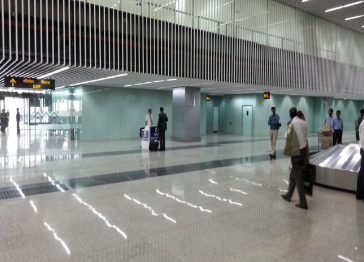
The International Arrivals section
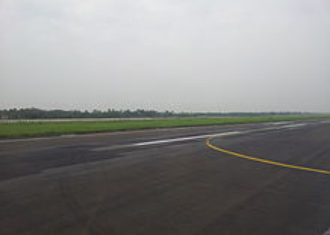
A view of the Runway 01R/19L.
The airport has two parallel runways 01/19 L/R, of which the longer one, 01R/19L is used for takeoffs and landings, while the shorter one is used mostly as a taxiway and for daytime landings. Air India operates hangars at the airport, while Bharat Petroleum and Indian Oil act as fuellers. Catering facilities are owned by Taj-Sats and Oberoi Flight Services
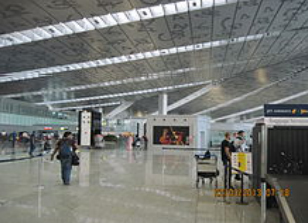
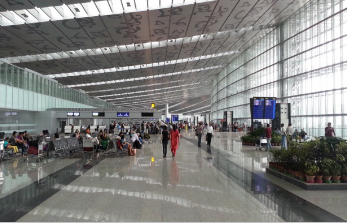
The Departures section in the new terminal.
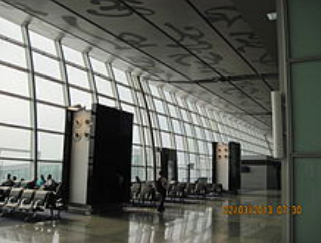
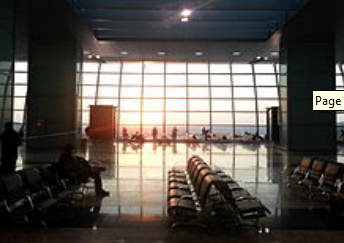
The waiting area of the terminal
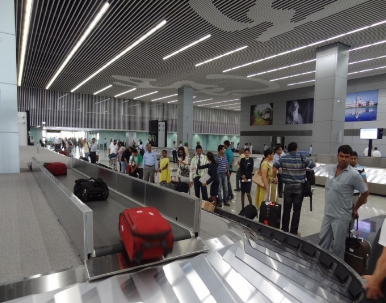
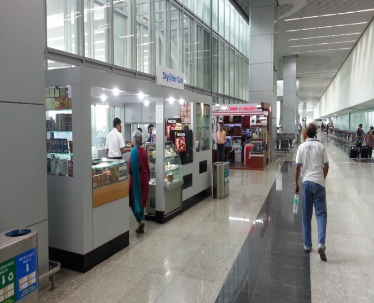
The Arrival section in the new terminal.
The airport's new integrated terminal is spread over 233,000 m2 (2,510,000 sq ft) and is able to handle 25 million passengers annually, compared to the previous terminals' capacity of five million. The terminal is an L-shaped structure, containing six levels. It contains 128 check-in counters that utilise CUTE (Common User Terminal Equipment) technology, and has 78 immigration counters and twelve customs counters. Passenger lounges are provided by Air India and Jet Airways. The terminal is equipped with 18 aerobridges. and a further 57 remote parking bays. There are plans to construct an 18-foot bronze statue of Netaji Subhas Chandra Bose in the integrated terminal complex.
Kolkata's old international and domestic terminals closed when the integrated terminal opened. However, the old international terminal may be used for future hajj services, and the domestic terminal may be used by regional airlines. An earlier proposal of continuing low-cost carrier operations from the existing domestic terminal has been shelved due to the need to fully utilise the new integrated terminal's capacity. In the financial year from April 2011 to March 2012, Kolkata airport served 10.3 million passengers, 85% which were travelling domestically. The withdrawal of Lufthansa's service to Frankfurt in March 2012 left Kolkata with no direct connections beyond Asia. However, other international operations increased in 2012. The new terminal has attracted some airlines to expand their route networks to include Kolkata. These include Malaysia Airlines, Xiamen Airlines, Turkish Airlines, Japan Airlines and FlyDubai. In September 2012, the Airports Authority of India upgraded the airport's cargo-handling capacity, enabling it to cater for the demand until 2015–16. There has been a 25 per cent growth in international cargo movement to and from Kolkata airport and a 15 per cent increase in outward transit. Automobileparts accounted for the bulk of the growth in the movement of cargo from the city to other countries. In November 2008 the first Centre for Perishable Cargo (CPC) in West Bengal was opened at the airport. The CPC has an area of 742.5 m2 (7,992 sq ft) and an annual storage capacity of 12,000 million tonnes. The CPC had been undergoing trials that started in June 2008 and was built with a 6.75 crore (US$1.1 million) grant-in-aid from the Agricultural and Processed Food Products Export Development Authority (APEDA) part of the Commerce Ministry. The volume of export was 21,683 ton in 2008–09, during the current fiscal more than 23,042 ton of cargo were handled by the airport authorities. Similarly the volume of import cargo was increased from 16,863 ton to 18,733 ton recording more than ten per cent jump during the same period. However, in 2008–09 the total volume of cargo handled by the airport declined by 4.8% from the previous year.
Expansion
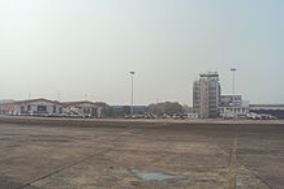
ATC complex CCU.
The construction of the new terminal, as well as runway expansion marked the end of Phase I in the project. AAI is prepared to execute Phase 2 of the Kolkata Airport expansion plan. This primarily involves around the construction of an 86 meter ATC Tower to provide controllers with a better view of the planes at the new terminal. The building will be accompanied by a sprawling 4 storey office complex. Additionally, the current Kolkata Metro expansion plans include two new lines to the airport, one from Noapara connecting at Barasat, and the other from New Garia. Both lines will converge at the airport and form an underground station.
Connectivity
The airport has a facility of prepaid taxis and air-conditioned buses that connect it to the city. As part of the larger modernisation programme, a flyover at Nagerbazar and an entry ramp on VIP Road have also been constructed. A 2 km flyover from Kestopur to Jora Mandir is being built to speed up the airport bound traffic. These should reduce journey time to the airport. Parking facilities at the new terminal include two underground parking levels accommodating 3000 cars, as well as a car park in the landscaped outdoor area which can handle an additional 2000 cars. Kolkata airport is connected to the Kolkata Suburban Railway system. It was the first airport in India to have such a connection, which opened in 2005. The four kilometre long elevated track connects the airport's Biman Bandar station with Dumdum Cantonment, passing Jessore Road. Electric multiple unit rolling stock serve the line. The railway line has seen poor patronage, leading to plans to replace it with a metro system.
Navigation
Kolkata airport is equipped with VOR/DME (frequency 112.50 MHz) and NDB (frequencies 385kHz & 404kHz). Communication frequencies for Tower is 118.1 MHz and Approach is 127.9 MHz. The airport's operating hours are 24-hours.
Know Kolkata
-
Kolkata Hotels
Hotels Near Airport
-
Kolkata Nights
Clubs Near Airport
-
Kolkata Hotspots
Tourist Spots Near Kolkata
-
Kolkata Spirituals
Religious Spots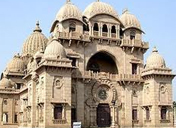
-
Kolkata Food
River Cruise In Ganges


